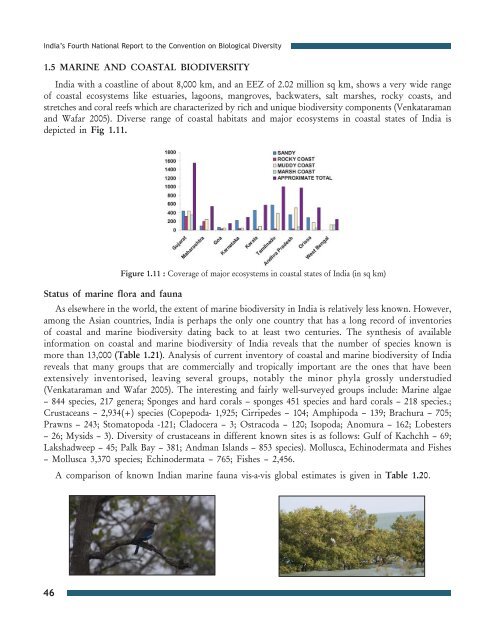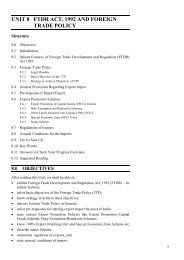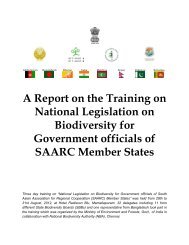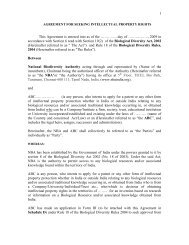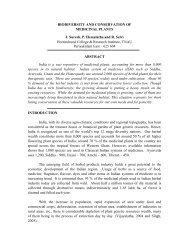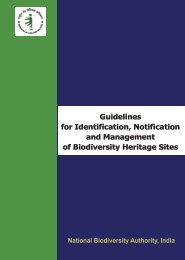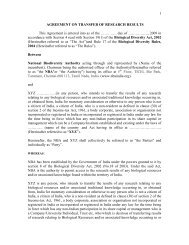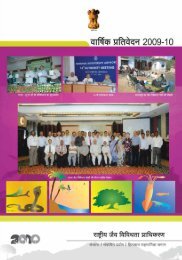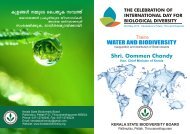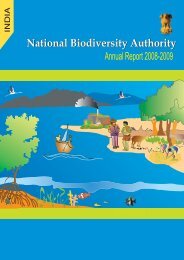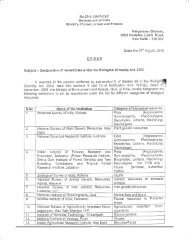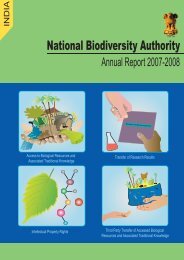Part 1 - English version (PDF) - Convention on Biological Diversity
Part 1 - English version (PDF) - Convention on Biological Diversity
Part 1 - English version (PDF) - Convention on Biological Diversity
You also want an ePaper? Increase the reach of your titles
YUMPU automatically turns print PDFs into web optimized ePapers that Google loves.
India’s Fourth Nati<strong>on</strong>al Report to the <str<strong>on</strong>g>C<strong>on</strong>venti<strong>on</strong></str<strong>on</strong>g> <strong>on</strong> <strong>Biological</strong> <strong>Diversity</strong><br />
1.5 MARINE AND COASTAL BIODIVERSITY<br />
India with a coastline of about 8,000 km, and an EEZ of 2.02 milli<strong>on</strong> sq km, shows a very wide range<br />
of coastal ecosystems like estuaries, lago<strong>on</strong>s, mangroves, backwaters, salt marshes, rocky coasts, and<br />
stretches and coral reefs which are characterized by rich and unique biodiversity comp<strong>on</strong>ents (Venkataraman<br />
and Wafar 2005). Diverse range of coastal habitats and major ecosystems in coastal states of India is<br />
depicted in Fig 1.11.<br />
Figure 1.11 : Coverage of major ecosystems in coastal states of India (in sq km)<br />
Status of marine flora and fauna<br />
As elsewhere in the world, the extent of marine biodiversity in India is relatively less known. However,<br />
am<strong>on</strong>g the Asian countries, India is perhaps the <strong>on</strong>ly <strong>on</strong>e country that has a l<strong>on</strong>g record of inventories<br />
of coastal and marine biodiversity dating back to at least two centuries. The synthesis of available<br />
informati<strong>on</strong> <strong>on</strong> coastal and marine biodiversity of India reveals that the number of species known is<br />
more than 13,000 (Table 1.21). Analysis of current inventory of coastal and marine biodiversity of India<br />
reveals that many groups that are commercially and tropically important are the <strong>on</strong>es that have been<br />
extensively inventorised, leaving several groups, notably the minor phyla grossly understudied<br />
(Venkataraman and Wafar 2005). The interesting and fairly well-surveyed groups include: Marine algae<br />
– 844 species, 217 genera; Sp<strong>on</strong>ges and hard corals – sp<strong>on</strong>ges 451 species and hard corals – 218 species.;<br />
Crustaceans – 2,934(+) species (Copepoda- 1,925; Cirripedes – 104; Amphipoda – 139; Brachura – 705;<br />
Prawns – 243; Stomatopoda -121; Cladocera – 3; Ostracoda – 120; Isopoda; Anomura – 162; Lobesters<br />
– 26; Mysids – 3). <strong>Diversity</strong> of crustaceans in different known sites is as follows: Gulf of Kachchh – 69;<br />
Lakshadweep – 45; Palk Bay – 381; Andman Islands – 853 species). Mollusca, Echinodermata and Fishes<br />
– Mollusca 3,370 species; Echinodermata – 765; Fishes – 2,456.<br />
A comparis<strong>on</strong> of known Indian marine fauna vis-a-vis global estimates is given in Table 1.20.<br />
46


